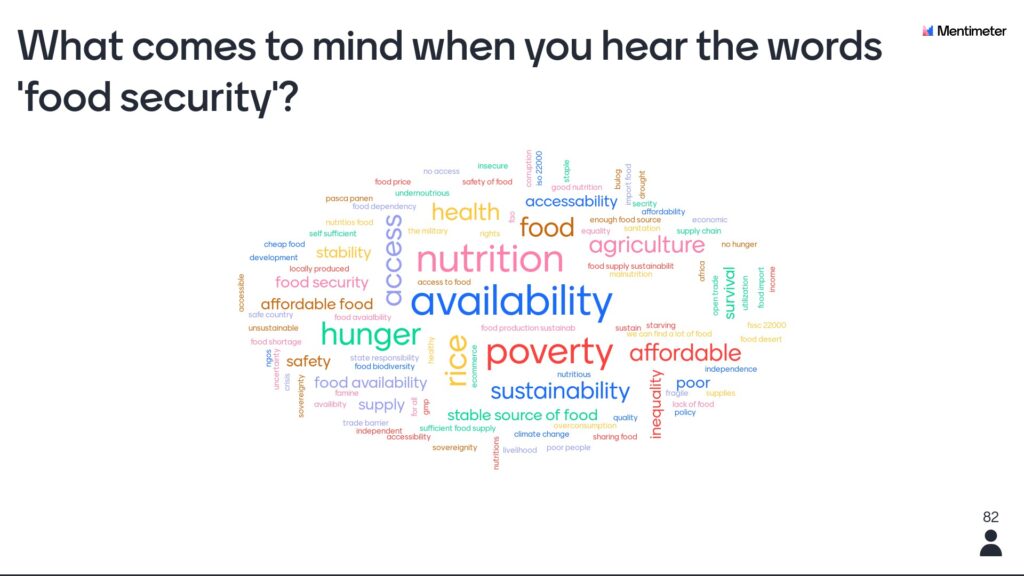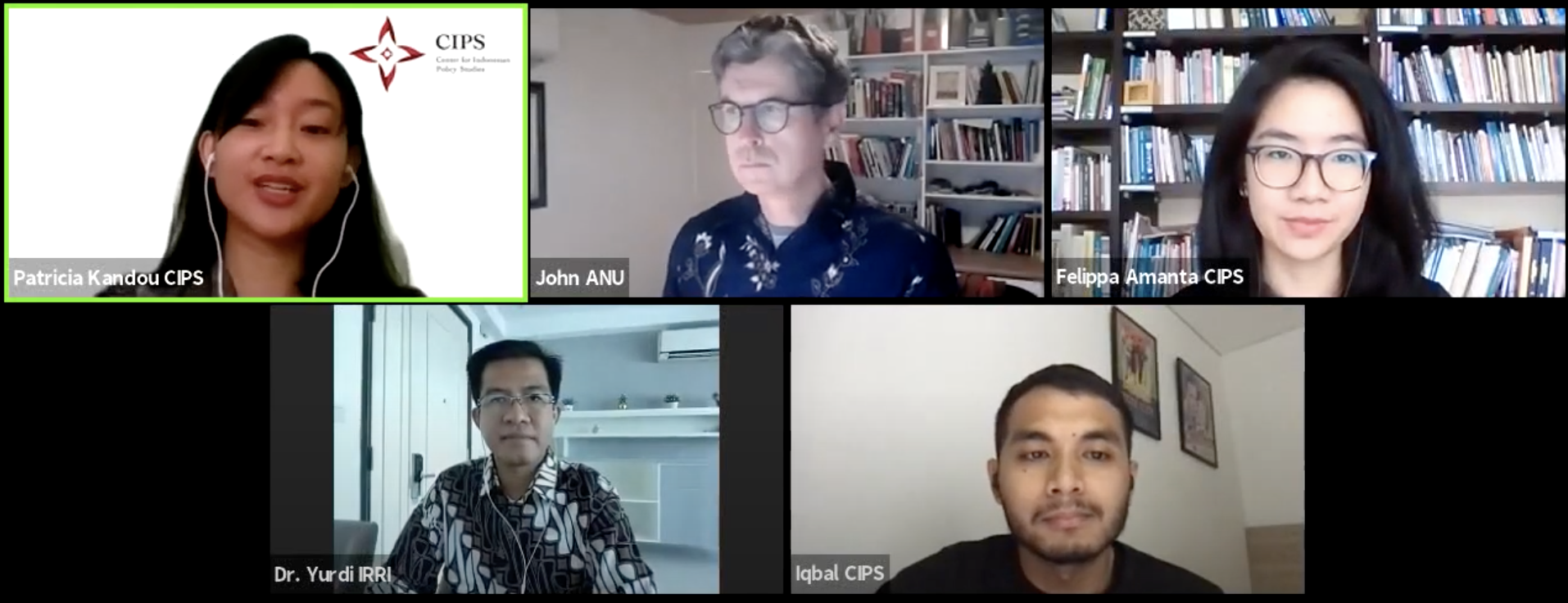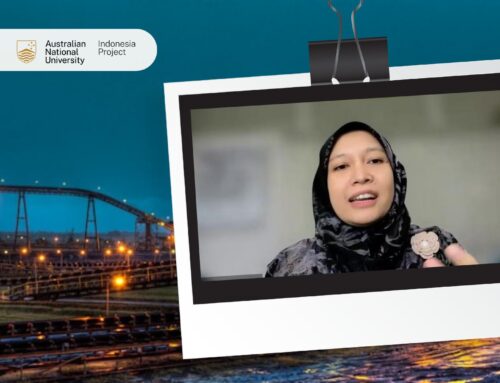FKP hosted by the Center for Indonesian Policy Studies (CIPS) with Felippa Amanta and Iqbal Wibisono (CIPS), John McCarthy (The Australian National University/ANU), and Yurdi Yasmi (International Rice Research Institute/IRRI). Thursday, 2 July 2020.
Keypoints:
- Though Indonesia has made significant progress in reducing the poverty rate, millions of people are still enduring hunger and consuming low quantity and quality of food. The COVID-19 pandemic further worsen the situation and new challenges threaten the national food system.
- Indonesian and regional Southeast Asian domestic food supply and production systems are largely functioning, with no supply shortages detected. The main problem is the declining ability to purchase good quality and nutritious food as people lost livelihoods due to unemployment, social distancing and breakdown in agro-food supply chains.
- An existing high dependency on import and ineffective non-tariff measures (NTM) lead to increase in food prices. NTM and quantitative restrictions are adversely impacting the level of poverty, inequality and consumption of food.
- Coping with worsened situation due to the pandemic, Indonesia has to build a more resilient food system and diversified livelihoods. Local and regional responses with neighboring Southeast Asian nations also need to be strengthened.
___________________________________________________________________
- Before the COVID-19 pandemic, Indonesia had made a significant progress in reducing the poverty rate. However, many Indonesians still experience food insecurity with the country ranking 62 in the Global Food Security Index (2019) below Singapore (rank 1), Malaysia (28), Thailand (52) and even Vietnam (54). Indonesia scored low on food affordability, food availability and, of particular concern, food quality and safety. At the national level, 38% of Indonesian households cannot afford a nutritious diet. The proportion is even higher for some provinces such as Papua (48%), Maluku (56%) and NTT (68%).
- The COVID-19 pandemic is expected to push millions of people in Indonesia toward poverty, reversing the progress made in the last two decades. The SMERU Research Institute estimate that an additional 1.3m (the mildest scenario) to 23.4m (worse scenario) people may be pushed under poverty by the pandemic. This will, in turn, exacerbate the problem of food security.
- John McCarthy (ANU) is leading a team of researchers analyzing the impact of the pandemic at the sub-national level in Indonesia focusing on 5 types of landscapes/food production systems and applying a set of risk exposure indicators.Their preliminary findings include:
- Households who specialize on a single commodity (e.g. oil palm or rubber producers); those without land; and those with precarious livelihoods (e.g. daily laborers) are particularly heavily impacted.
- The impacts are less in terms of reduction in food production(or supply disruption) but rather a decline in demand for labor and in opportunities to sell/trade products that are driving people into poverty or near-poor condition with low ability to access nutritious food.
- As the pandemic continues, falling income, disrupted supply chain and limited social safety net allowances may lead people to consume cheaper, lower quality food –more carbohydrates and reducing consumption of fresh vegetables, fish, meat and fruits. Over time, this will increase the stunting problem and may turn to chronic food poverty.
- A key problem hampering food security is the ineffective non-tariff measures (NTM) in place in Indonesia. NTM are policy measures, other than ordinary customs tariff, that can potentially have an economic effect on international trade in goods by changing the quantities traded, the prices, or both. NTM can take the form of technical measures (e.g. labeling and quarantine requirements, testing or certification procedures, and inspecting prior to export) or non-technical measures (e.g. seasonal duties, minimum import price, quota, service charge). NTM on agro-food products in Indonesia are shown to be numerous, overlapping and redundant. As of July 2020 there are 433 NTM on agro-food products in Indonesia, resulting in artificial scarcity and compliance costs associated with importing food.
- CIPS researchers undertook and assessment to estimate the effects of removing NTM and reversing quantitative restrictions/QR (which limit the amount of a good that can be legally imported) on rice & meat on 1) poverty, 2) inequality and 3) consumption, using the 2015 the National Socio-economic Survey (SUSENAS) data. Some of the preliminary findings indicate that NTM removal and QR reversalhave positive effects to poverty and inequality, and to consumption by the poorest groups in the population.COVID-19 pandemic also results in food-related challenges throughout Southeast Asia. According to Yurdi Yasmi (IRRI) the four main challenges for the region are increased risk of food insecurity; changes in consumer demand as more people cook meals at home; disruptions to value chains; and inequities to women and children. Four population groups are particularly vulnerable: the poor, those who lost their jobsdue to the pandemic; those who must return to their hometown and become a new burden; pregnant & lactating women; and children.
- Consistent with the findings on the Indonesian domestic situation, the regional impacts are more in terms of decreasing income rather than a supply shock. Rice, the region’s main staple food, has been largely available. Domestic food prices are also stable in ASEAN, and export bans on rice and other agricultural products temporarily imposed by some countries in the early stages of COVID-19, have all been lifted. However, restriction on movement (lockdown, closing of business, disruptions of supply chains), job losses, and reduced remittances are heavily impacting the ability of households across Southeast Asia to access food despite available food supply.
- Given structural weaknesses in the food system, can the policy responses to the pandemic also be opportunities for rethinking and rebuilding the food system in Indonesia and the region? Recommendations in this direction include rethinking access to agricultural inputs; provision of reliable logistical infrastructure between consumers and markets; solution to high food prices; building diverse livelihoods and diets; and conserving ecosystems and reducing ecological risks.
More than 300 people participated in the webinar, and the topics raised by participants (in the form of comments or questions) included the role of e-commerce in connecting buyers and sellers; the impacts of COVID-19 in eastern Indonesia; the planned food estate in Kalimantan; and the role of agriculture. Participants were also interested on the rural vs urban impacts and Java vs off-Java impacts.
Press coverage:

The words generated by webinar participants. The more prominent the words in the word cloud above (e.g. the words availability, nutrition, poverty, hunger), the larger the number of participants writing these words as what comes to their mind about ‘food security’.





